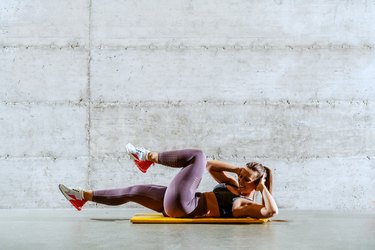
When done correctly, bicycle crunches are an absolute ab-scorcher, since they fire up your obliques and six-pack muscles. In fact, the American Council on Exercise ranks bicycle crunches in their top three ab exercises.
But this movement requires more attention to detail than you might think. And if your form isn't on point, you won't get the most out of this awesome ab exercise. Here, Anthony Crouchelli, celebrity trainer and creator of The .1Method, breaks down the most common bicycle crunch mistakes, plus offers tips on how to nail the perfect form.
Video of the Day
How to Nail Proper Bicycle Crunch Form
- Begin lying face up with your knees bent at 90 degrees over your hips and your hands clasped behind your head.
- Exhale and round your spine, lifting your head and shoulders off the floor.
- Twist your torso and draw your left knee in so that your right elbow touches it.
- Twist the opposite way so that your left elbow meets your right knee.
Avoid These 6 Worst Bicycle Crunch Mistakes
1. You Pull on Your Neck
If your neck hurts during bicycle crunches, something's off with your form. "Tugging on your neck is the number one issue that we often see inside this movement sequence," Crouchelli says.
Not only does straining the neck cause discomfort, it also makes your abs work less hard. "People tend to grasp or hold on with such tension that they are in fact never truly activating the cross body focus of this exercise," he says.
Fix It
“Instead of ‘holding’ onto your neck, think of simply resting your hands behind your neck with the intention of this position just being a placement for your hands as opposed to an activator for the movement,” Crouchelli says.
2. You Close Your Chest
"Closing your chest can lead to neck discomfort as well as spine curvature, which is not ideal in most core-based movements," Crouchelli says. And while it's easy to collapse the chest (and elbows), especially when you're fatigued, this limits the range of motion — and thus the oblique work — of the movement.
Fix It
“Interlace your fingers gently behind your head while rolling your shoulders back, creating an expansion in your chest to hit full activation in the contraction of the exercise without any strain,” Crouchelli says.
3. You Don’t Press Through Your Heels
While bicycle crunches target your abs, that's no excuse to let your feet and legs go lax and limp. "Pressing through your heels allows you to activate the cross stabilization," Crouchelli says. That keeps everything engaged and makes sure all your muscles are firing to their full potential.
Fix It
Adding a two-second pause at the top of the contraction is a great reminder to drive through your heels and move your legs with intention, Crouchelli says.
4. You Speed Through the Movement
If you pedal like you're trying to PR in a bike race, you're shortchanging yourself. People tend to rush through bicycle crunches instead of developing a proper foundation for the movement, Crouchelli says.
And when you sprint through, you rely on momentum (not muscle) and decrease time under tension. In other words, you don't reap the maximum benefits. Going too fast can also lead to lifting or rocking the hips. But in order to effectively work your core, your hips need to be stable and in place.
Fix It
Pausing at the top of the movement or incorporating a tempo (for example, hold for 2 counts before switching legs) can remind you to slow down and activate your core muscles, Crouchelli says.
5. You Arch Your Lower Back
Does your lower back lift off the mat when you pump through bicycle crunches? This can place pressure and strain on your back and hips. And if you do it often enough, it can lead to back pain.
Fix It
“Always think of driving your naval into your spine, which in simpler terms is tucking your belly button,” says Crouchelli, adding that it's also important to press your lower back toward the ground.
Lastly, make sure your legs are slightly higher than your hips. Your back will tend to arch if your legs are too low to the ground, especially if you haven’t yet built enough core strength.
6. You Swing Your Elbow Toward Your Knee
When you swing your elbow to reach your knee, you're not really using your abs to perform the crunch. Instead, "you're forcing the movement of cross activation as opposed to effectively working through the pattern," Crouchelli says.
Plus, you might also experience discomfort or tension in the lumbar (lower back) area, he says.
Fix It
Use a tempo throughout the pattern to slow down and control the movement, Crouchelli says.
Was this article helpful?
150 Characters Max
0/150
Thank you for sharing!
Thank you for your feedback!